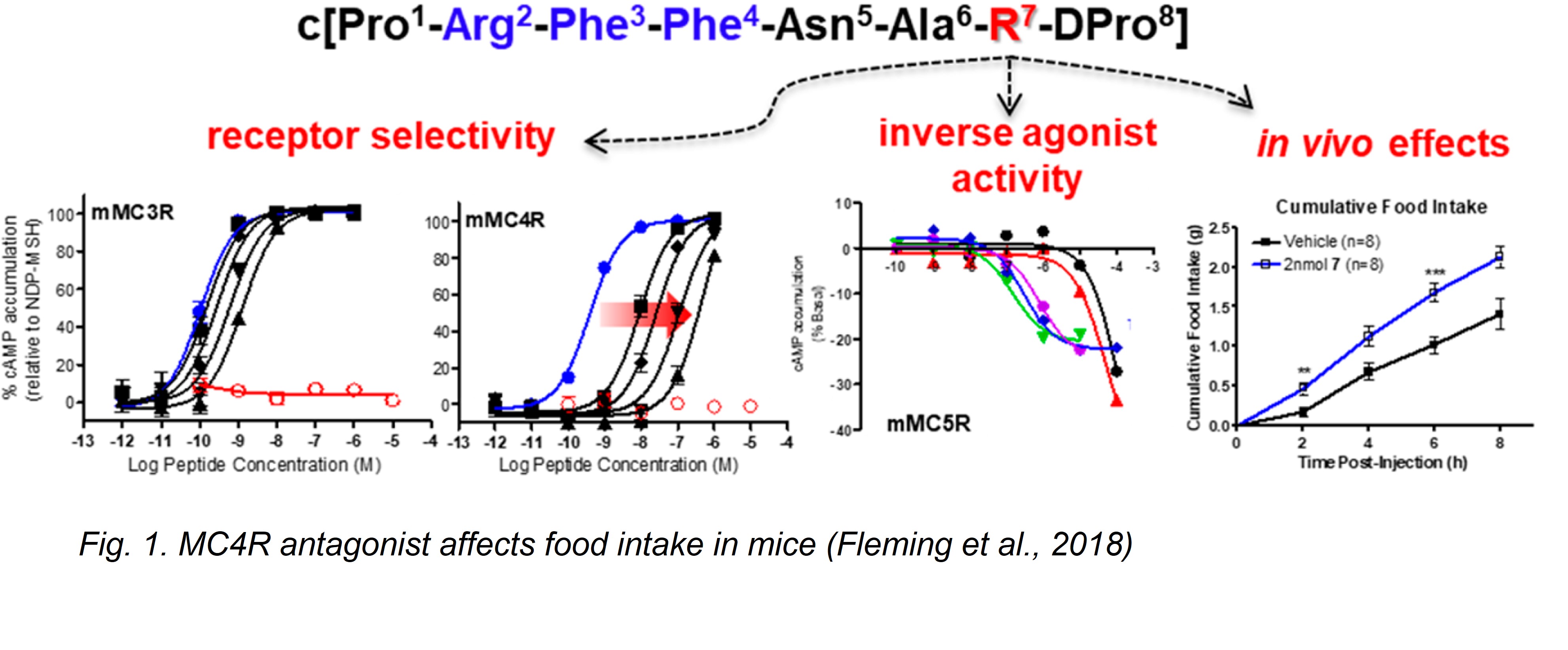AGRP-derived melanocortin receptor ligands
Identifying a selective MC4R antagonist for appetite modulation

Applications
- Treatment of anorexia-cachexia
Key Benefits & Differentiators
- Appetite modulation: MC4R antagonist increases food intake in mice
Technology Summary
In the US over 5 million people suffer from cachexia, a serious condition of extreme weight loss and muscle wasting common in people with cancer, chronic heart failure, HIV/AIDS, chronic obstructive pulmonary disease, chronic kidney disease and other chronic diseases. In cancer patients, cachexia increases hospitalization costs, length of stay and mortality. While many biological pathways control appetite and weight, the final step is controlled by two brain receptors, melanocortin receptors 3 and 4 (MC3R and MC4R, respectively). Activation of MC4R results in decreased food intake while blocking MC4R results in increased food intake. Therefore, MC4R offers a druggable target in the pursuit of treatments for anorexia-cachexia syndrome.
Researchers at the University of Minnesota leveraged the Agouti-related protein (AGRP), a potent orexigenic peptide that antagonizes MC3R and MC4R, to generate novel peptides that are highly potent and selective antagonists against MC4R. The AGRP-derived peptides were designed to mimic the active β-hairpin secondary structure that contains the hypothesized Arg-Phe-Phe pharmacophore. The most potent scaffold, c[Pro1-Arg2-Phe3-Phe4-Asn5-Ala6-Phe7-DPro8], comprised the hexa-peptide β-hairpin loop from AGRP cyclized through a DPro−Pro motif. However, this scaffold is 16-fold less potent than AGRP at the mouse MC4R (mMC4R) thus necessitating modifications to facilitate studies in mouse models. A more potent mMC4R antagonist was generated containing a Phe7 to Nle7 substitution. This peptide was equipotent to the lead ligand 200-fold selective for the mMC4R over the mMC3R and caused a significant increase in food intake when injected intrathecally into male mice (Fig 1). These compounds are a first step to developing MC4R antagonists for treating underweight conditions, including cachexia.
Phase of Development
TRL: 4-6Food intake studies in mice
Desired Partnerships
This technology is now available for:- License
- Sponsored research
- Co-development
Please contact our office to share your business’ needs and learn more.
Researchers
- Carrie Haskell-Luevano, PhD Professor, Department of Medicinal Chemistry
- Mark Ericson, PhD Research Assistant Professor, Department of Medicinal Chemistry
Licensing Terms
| MN-IP Try and Buy |
|---|
Try
|
Buy
|
-
expand_more library_books References (3)
- Ericson, M.D., Wilczynski, A., Sorensen, N.B., Xiang, Z. and Haskell-Luevano, C. , Discovery of a β-hairpin octapeptide, c [Pro-Arg-Phe-Phe-Dap-Ala-Phe-DPro], mimetic of agouti-related protein (87–132)[AGRP (87–132)] with equipotent mouse melanocortin-4 receptor (mMC4R) antagonist pharmacology, Journal of medicinal chemistry
- Ericson, M.D., Freeman, K.T., Schnell, S.M., Fleming, K.A. and Haskell-Luevano, C. , Structure–Activity Relationship Studies on a Macrocyclic Agouti-Related Protein (AGRP) Scaffold Reveal Agouti Signaling Protein (ASP) Residue Substitutions Maintain Melanocortin-4 Receptor Antagonist Potency and Result in Inverse [...], Journal of medicinal chemistry
- Fleming, K.A., Ericson, M.D., Freeman, K.T., Adank, D.N., Lunzer, M.M., Wilber, S.L. and Haskell-Luevano, C , Structure–Activity Relationship Studies of a Macrocyclic AGRP-Mimetic Scaffold c[Pro-Arg-Phe-Phe-Asn-Ala-Phe-DPro] Yield Potent and Selective Melanocortin-4 Receptor Antagonists [...], ACS chemical neuroscience
-
expand_more cloud_download Supporting documents (1)Product brochureAGRP-derived melanocortin receptor ligands.pdf